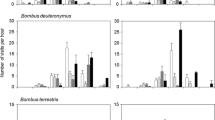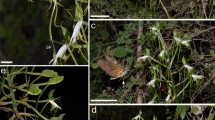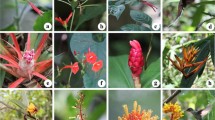Abstract
The large Saw-billed HermitRamphodon naevius and its foraging behaviour on a variety of ornithophilous flowers were studied at one site in the Atlantic rainforest in southeastern Brazil. The flower assemblage visited by this endemic hermit throughout the year is composed mainly by epiphytes and herbs, Bromeliaceae and Heliconiaceae being the staple foodplants. Most of the plant species present steady-state, long-tubed and high-reward flowers, and bloom sequentially. The Saw-billed Hermit is a year-round resident and traplining forager, behaves aggressively over its feeding routes, and excludes conspecifics and other hummingbird species from its main flower sources. This large hermit regularly visited and pollinated about 45 % of the native ornithophilous plants at the study site, thus acting as the major pollinator on this flower assemblage.
Zusammenfassung
Der große in Südbrasilien endemische Sägeschnabel-Schattenkolibri (Ramphodon naevius) und dessen Nahrungsverhalten an ornithophilen Blüten einer Pflanzengesellschaft des atlantischen Regenwaldes wurde untersucht. Die von ihm besuchten Blüten gehören hauptsächlich zu Kräutern und Epiphyten, wobei Bromeliaceen und Heliconiaceen die Hauptnahrungspflanzen bilden. Diese Arten haben eine lange Blühperiode und blühen konsekutiv. Die Blüten besitzen lange Kronröhren und sondern reichlich Nektar ab. Der standortstreue Kolibri hält eine bestimmte Route und einen Zeitplan bei der Nahrungsaufnahme ein; er verhält sich aggressiv sowohl gegenüber Individuen seiner eigenen Art als auch solchen anderer Kolibriarten, die er von den wichtigsten Nahrungsquellen vertreibt. Der Sägeschnabel-Schattenkolibri besuchte regelmäßig ca. 45 % der ornithophilen einheimischen Pflanzen einer bestimmten Gesellschaft. Damit ist er der wichtigste Bestäuber dieser Pflanzen.
Similar content being viewed by others
Literature
Araujo, A. C., E. A. Fischer &M. Sazima (1994): Floração sequencial e polinização de três espécies de (Vriesea) (Bromeliaceae) na região de Juréia, sudeste do Brasil. Revta. brasil. Bot. 17: 113–118.
Arizmendi, M. C., &J. F. Ornelas (1990): Hummingbirds and their floral resources in a tropical dry forest in Mexico. Biotropica 22: 172–180.
Bawa, K. S. (1990): Plant-pollinator interactions in tropical rain forests. Ann. Rev. Ecol. Syst. 21: 399–422.
Bronstein, J. L. (1986): The origin of bract liquid in a neotropical (Heliconia) species. Biotropica 18: 111–114.
Dafni, A. (1992): Pollination ecology, a practical approach. Oxford.
Dunning, J. S. (1982): South American land birds. Pennsylvania.
Eiten, G. (1970): A vegetação do Estado de São Paulo. Bol. Inst. Bot. (São Paulo) 7: 1–147.
Ewald, P. W., &W. A. Williams (1982): Function of the bill and tongue in nectar uptake by hummingbirds. Auk 99: 573–576.
Feinsinger, P. (1976): Organization of a tropical guild of nectarivorous birds. Ecol. Monogr. 46: 257–291.
Ditto (1983): Coevolution and pollination. In:D. Futuyma &M. Slatkin, Coevolution: 282–310. Sunderland.
Ditto &S. B. Chaplin (1975): On the relationship between wing disc loading and foraging strategy in hummingbirds. Am. Nat. 108: 217–224.
Ditto &R. K. Colwell (1978): Community organization among neotropical nectar-feeding birds. Am. Zool. 18: 779–795.
Fischer, E. A. (1994): Polinização, fenologia e distribuição espacial de Bromeliaceae numa comunidade de Mata Atlântica, litoral sul de São Paulo. Unpubl. Master Th., Univ. Estadual de Campinas, São Paulo.
Franco, A. L. M., &S. Buzato (1992): Biologia floral deNematanthus fritschii (Gesneriaceae). Rev. Brasil. Biol. 52: 661–666.
Gentry, A. H. (1974): Coevolution patterns in Central American Bignoniaceae. Ann. Mo. Bot. Gdn. 61: 728–759.
Gould, J. (1990): Hummingbirds (fac-simile reprint of the Monograph of the Trochilidae, 1849–1861). Secaucus NJ.
Grantsau, R. (1989): Os beija-flores do Brasil. Rio de Janeiro.
Hainsworth, F. R. (1973): On the tongue of a hummingbird: its role in the rate and energetics of feeding. Comp. Biochem. Physiol. 46A: 65–78.
Heywood, V. H. (1982): Blütenpflanzen der Welt. Basel.
Höfling, E., &F. Lencioni (1992): Avifauna da floresta atlântica, região de Salesópolis, Estado de São Paulo. Rev. Brasil. Biol. 52: 361–378.
Holmgren, P., &W. Keuken (1990): Index Herbariorum, Part I — The herbaria of the world. (8th ed.). Utrecht.
Hueck, K. (1972). As florestas da América do Sul. São Paulo.
Inouye, D. W. (1980): The terminology of floral larceny. Ecology 61: 1251–1253.
Janzen, D. (1975): Ecology of plants in the tropics. London.
Kraemer, M. A., U. Schmitt &K.-L. Schuchmann (1993): Notes on the organization of a Neotropical high-altitude hummingbird-flower community. In:W. Barthlott, C. M. Naumann, K. Schmidt-Loske &K.-L. Schuchmann, Animal-plant interactions in tropical environments: 61–65. Bonn.
Neill, D. A. (1987): Trapliners in the trees: hummingbird pollination ofErythrina sect.Erythrina (Leguminosae: Papilionoideae). Ann. Mo. Bot. Gdn. 74: 27–41.
Nimer, E. (1977): Climatologia da região sudeste do Brasil. Rev. Brasil. Geogr. 34: 3–48.
Prance, G. T., &D. C. Campbell (1988): The present state of tropical floristics. Taxon 37: 519–548.
Ruschi, A. (1982): Beija-flores do Estado do Espírito Santo. São Paulo.
Sazima, I., S. Buzato &M. Sazima (1993): The bizarre inflorescence ofNorantea brasiliensis (Marcgraviaceae): visits by hovering and perching birds. Bot. Acta 106: 507–513.
Sazima, M. (1977): Hummingbird pollination ofBarbacenia flava (Velloziaceae) in the Serra do Cipó, Minas Gerais, Brazil. Flora 166: 239–247.
Sick, H. (1985): Ornitologia brasileira, uma introdução. Vol. I. Brasília.
Snow, B. K. (1973): The behavior and ecology of hermit hummingbirds in the Kanaku Mountains, Guyana. Wilson Bull. 85: 163–177.
Ditto (1981): Relationships between hermit hummingbirds and their food plants in eastern Ecuador. Bull. B.O.C. 101: 387–396.
Snow, D. W., &B. K. Snow (1980): Relationships between hummingbirds and flowers in the Andes of Colombia. Bull. Br. Mus. nat. Hist. (Zool.) 38: 105–139.
Ditto (1986): Feeding ecology of hummingbirds in the Serra do Mar, south-eastern Brazil. El Hornero 12: 286–296.
Ditto &D. Teixeira (1982): Hummingbirds and their flowers in the coastal mountains of southeastern Brazil. J. Orn. 123: 446–450.
Stein, B. A. (1992): Sicklebill hummingbirds, ants, and flowers. BioScience 42: 27–33.
Stiles, F. G. (1975) Ecology, flowering phenology and hummingbird pollination of some Costa RicanHeliconia species. Ecology 56: 285–301.
Ditto (1978): Temporal organization of flowering among the hummingbird foodplants of a tropical wet forest. Biotropica 10: 194–210.
Ditto (1981): Geographical aspects of bird-flower coevolution, with particular reference to Central America. Ann. Mo. Bot. Gdn. 68: 323–351.
Ditto (1985): Seasonal pattern and coevolution in the hummingbird-flower community of a Costa Rican subtropical forest. In:P. A. Buckley, M. S. Morton, R. S. Ridgely &F. G. Buckley, Neotropical ornithology: 757–787. Washington, D. C.
Ditto &C. E. Freeman (1993): Patterns in floral nectar characteristics of some bird-visited plant species from Costa Rica. Biotropica 25: 191–205.
Toledo, V. M. (1975): La estacionalidad de la flores utilizadas por los colibríes de una selva tropical húmeda en México. Biotropica 7: 63–70.
Willis, E. O. &Y. Oniki (1981): Levantamento preliminar de aves em treze áreas do Estado de São Paulo. Rev. Brasil. Biol. 41: 121–135.
Wolf, L. L., F. G. Stiles &F. R. Hainsworth (1976): Ecological organization of a tropical, highland hummingbird community. J. Anim. Ecol. 32: 349–379.
Young, A. M. (1971): Foraging for insects by a tropical hummingbird. Condor 73: 36–45.
Author information
Authors and Affiliations
Rights and permissions
About this article
Cite this article
Sazima, I., Buzato, S. & Sazima, M. The Saw-billed HermitRamphodon naevius and its flowers in southeastern Brazil. J Ornithol 136, 195–206 (1995). https://doi.org/10.1007/BF01651241
Published:
Issue Date:
DOI: https://doi.org/10.1007/BF01651241




